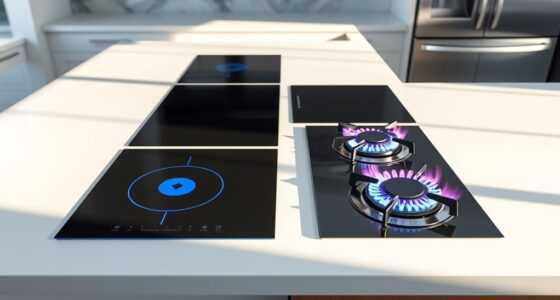Hard water causes mineral buildup that can damage your coffee maker and affect the taste. To descale like a pro, start by inspecting your machine for signs like slow brewing or mineral deposits. Make a vinegar-water solution, usually equal parts, and run it through your machine, pausing halfway to let it soak. Finish with rinse cycles of clean water. Keep your equipment in top shape by learning how to prevent future scale buildup and guarantee great coffee every time.
Key Takeaways
- Regularly inspect for white crust, mineral deposits, or slow brewing signs to identify scale buildup early.
- Prepare a vinegar-water solution tailored to soil level (50/50 to 70/30) for effective descaling.
- Run a descaling cycle by filling the reservoir, brewing halfway, pausing, then completing, followed by two water-only rinses.
- Disassemble and clean removable parts with warm, soapy water to prevent residue buildup.
- Install a water softener and test water hardness periodically to reduce mineral content and prevent future scale issues.
Understanding the Impact of Hard Water on Your Coffee Equipment

Hard water can markedly impact your coffee equipment because it contains high levels of dissolved minerals like calcium and magnesium. These minerals accumulate over time, leading to scale buildup inside your machine. When water is heated, calcium and other minerals form calcium carbonate deposits, which cling to heating elements, pipes, and filters. This buildup reduces your coffee maker’s efficiency, making it work harder and longer to brew. It can also cause metallic tastes in your coffee, diminishing flavor quality. Water hardness, measured in parts per million (ppm), indicates how prone your machine is to scaling; above 120 ppm, hard water is more likely to cause problems. Using softened or filtered water helps cut down mineral content, preventing scale formation and prolonging your coffee maker’s lifespan. Additionally, understanding your water’s mineral content can help you manage scaling more effectively and ensure better-tasting coffee. Regular descaling with appropriate solutions is essential to maintain optimal performance and extend the life of your equipment, especially when hard water levels are high. Incorporating descaling routines with natural remedies like vinegar or citric acid can also be effective and environmentally friendly. To further prevent mineral deposits, some users opt for aqua filters designed specifically for coffee machines. Proper maintenance can also reduce the risk of damage to internal components, further extending your machine’s operational life.
Recognizing When Your Coffee Maker Needs a Descale

Knowing when to descale your coffee maker is essential to keep it running smoothly. Scale buildup from hard water often shows as white crust or mineral deposits around the water outlet and drip tray. If you notice these, it’s a clear sign you need to descale. Additionally, a noticeable slowdown in brewing speed or longer extraction times indicate mineral deposits are obstructing water flow. You might also detect a metallic or sour taste in your coffee, which signals scale residues. Reduced water pressure during brewing and unusual noises or overheating further point to internal scale buildup. Recognizing these signs early helps prevent damage and maintains coffee quality. Regularly inspecting your machine ensures you catch scale buildup before it causes serious issues. Being aware of hard water effects can help you take proactive steps to maintain your coffee maker’s performance. Incorporating descaling routines into your maintenance schedule can extend the lifespan of your appliance and preserve your coffee’s flavor. Additionally, understanding the health implications of scale can motivate more consistent maintenance. Furthermore, using appropriate descaling solutions can effectively dissolve mineral deposits without harming your machine.
Preparing the Perfect Vinegar-Based Cleaning Solution

To prepare an effective vinegar-based cleaning solution, mix equal parts white vinegar and water. If your machine is heavily scaled, increase the vinegar ratio for better mineral removal. Always use a fresh mixture and guarantee it covers all internal parts for maximum cleaning power. Incorporating industry trends into your routine can also help maintain your coffee maker’s performance over time. Additionally, ensuring consistent descaling practices aligns with sound healing science, which emphasizes the importance of regular care to promote overall well-being. Regular maintenance routines can also extend the lifespan of your coffee maker, preventing costly repairs. Monitoring your machine’s performance with advanced diagnostic tools can further optimize its longevity and efficiency. Staying informed about technological advancements can help you adopt new methods for more effective descaling.
Vinegar and Water Ratio
Creating an effective vinegar-based descaling solution starts with mixing equal parts white distilled vinegar and water. This 1:1 ratio guarantees a safe, reliable clean that dissolves mineral buildup without harming your coffee maker. For heavily scaled machines, you can increase the vinegar slightly to boost mineral breakdown, but stick close to the 1:1 ratio for best results. Always prepare fresh vinegar-water solutions for each cycle to maintain cleaning power. Avoid commercial cleaners that are diluted or pre-mixed; they can be less effective and unpredictable. Making sure the solution fully covers all internal components is essential for thorough descaling. Using the correct descaling ratio ensures your coffee maker receives an effective deep clean. Properly cleaning and maintenance extends the lifespan of your appliance and keeps your coffee tasting great. Additionally, understanding your water hardness can help you adjust the vinegar ratio for optimal cleaning efficiency. When you get the ratio right, you’ll feel confident that your coffee maker is getting the deep clean it needs to brew better-tasting coffee every time.
Adjust for Soil Level
When your coffee maker has stubborn mineral buildup or heavy soil, adjusting the vinegar-to-water ratio guarantees a more effective clean. For light scale or minor deposits, stick to equal parts vinegar and water. If the soil level is moderate, increase the vinegar to about 60%. For heavy buildup, use up to 50% vinegar to boost descaling power. Visualize the differences:
| Soil Level | Vinegar Ratio | Effect |
|---|---|---|
| Light soil | 50/50 | Gentle cleaning |
| Moderate soil | 60/40 | Better scale removal |
| Heavy soil | 70/30 or 50/50 | Strong descaling, stubborn deposits |
Always ensure the mixture completely covers all internal components for thorough cleaning. Adjust based on the severity of soil or scale, especially if you want to prevent future buildup by understanding scale formation and how it impacts your appliance. Being aware of how scale buildup develops can help you tailor your descaling frequency and prevent damage to your coffee maker. Additionally, maintaining proper water quality can significantly reduce the rate of mineral deposits forming inside your machine. Regular cleaning with an appropriate mixture also helps remove mineral deposits before they cause serious issues. Incorporating preventive maintenance practices can extend the lifespan of your coffee maker and improve its performance over time.
Use Fresh Solution
Using a fresh vinegar-water solution each time you descale guarantees maximum effectiveness and prevents bacterial growth. Reusing old solution can reduce acidity, making descaling less effective and risking mold. Always fill your water tank with a mixture of equal parts white distilled vinegar and water, covering all internal components. For heavily soiled machines, increase the vinegar proportion to break down minerals more efficiently. Avoid reusing leftover solution to ensure ideal sanitizing and mineral removal. This approach aligns with your water softeners and descaling efforts, keeping your machine clean and functioning smoothly. Remember, fresh solutions mean a thorough cleanse, better taste, and longer-lasting equipment. Don’t cut corners—every descale should be a fresh start for your coffee maker’s health and performance. Using a fresh solution also helps prevent mineral buildup and extends the lifespan of your appliance.
Disassembling and Cleaning Internal Components Effectively

To clean the internal components of your coffee maker effectively, start by removing the water tank, filter basket, and any other removable parts. This disassembly allows you to access hidden areas for thorough cleaning. Wash each part with warm, soapy water to remove oils and mineral deposits that can affect flavor and performance. After cleaning, gently dry all components with a clean towel to prevent water spots and mold growth. During disassembly, check internal passageways and accessible areas for scale buildup or damage. Use a soft brush if necessary to dislodge stubborn deposits. Also, inspect seals and gaskets for wear or damage, replacing them if needed. Carefully reassemble all parts, ensuring they fit snugly to prevent leaks and maintain ideal operation after cleaning.
Running a Descaling Cycle to Dissolve Mineral Buildup

After thoroughly cleaning the internal components, it’s time to run a descaling cycle to remove mineral buildup. Fill the water reservoir with a descaling solution or a mix of equal parts white vinegar and water. Initiate a standard brewing cycle, then turn off the machine halfway through to let the solution soak inside for 30 minutes to an hour. This step helps break down stubborn mineral deposits. Resume and complete the cycle to ensure the descaling solution dissolves all scale buildup. Once done, run two or more water-only rinse cycles to flush out any remaining vinegar or solution. Regular descaling keeps your coffee maker performing at its best.
- Feel the satisfaction of a clean, mineral-free machine
- Enjoy better-tasting coffee every morning
- Prevent costly repairs from mineral buildup
- Experience the joy of effortless maintenance
Rinsing Thoroughly to Remove Vinegar Residues

Once you’ve completed the descaling process, it’s essential to thoroughly rinse your coffee maker to eliminate any remaining vinegar residues. Run at least two full water-only cycles to flush out any leftover vinegar taste. Use a fresh, clean coffee filter during each rinse to prevent debris from recontaminating the machine. Confirm each rinse cycle uses enough water to dilute and remove any lingering vinegar or mineral residues. Verify the machine’s internal components are free of vinegar smell and taste before brewing coffee again. Repeat rinsing if necessary until no residual vinegar flavor or odor remains.
| Step | Action | Tips |
|---|---|---|
| Run rinse cycles | Use clean water, at least twice | Use fresh filters each time |
| Check for odors/taste | Verify no vinegar smell or flavor | Repeat if needed |
| Use sufficient water | Dilute and remove residues effectively | Ensure thorough rinsing |
Maintaining a Regular Cleaning Schedule for Longevity

Regularly scheduling your coffee maker’s cleaning is essential for maintaining its performance and extending its lifespan. Consistent descaling and cleaning prevent mineral buildup, ensuring each brew tastes fresh and rich. Set a reminder to descale every 3 to 6 months, or more often if your water’s very hard. Don’t forget to clean removable parts like filters and water tanks to remove oil and residue. Keep an eye out for signs like slower brewing or strange flavors—they’re clues it’s time for a cleaning session. By sticking to a routine, you’ll avoid costly repairs and enjoy consistently great coffee.
- Feel confident knowing your machine runs smoothly each morning
- Enjoy the rich, pure flavors of every cup
- Save money by preventing scale damage
- Take pride in extending your coffee maker’s lifespan
Choosing Soft Water Options to Prevent Future Scale

Installing a water softener like a Kinetico system can drastically reduce mineral content, preventing scale buildup in your coffee maker. Soft water improves your brew’s flavor and extends your equipment’s lifespan. Regularly testing and maintaining your softening system keeps water quality high and avoids future descaling issues.
Installing Water Softeners
Choosing the right water softener is essential for preventing limescale buildup in your coffee maker. Installing a Kinetico water softener can cut calcium and magnesium levels by up to 99%, safeguarding your machine from costly descaling. Water softeners use ion exchange resins to swap hard minerals for sodium or potassium ions, producing soft, scale-free water perfect for brewing. A professionally installed system not only protects your coffee maker but also extends its lifespan by reducing mineral deposits that cause clogs and inefficiency. Regular maintenance and regeneration of your softener ensure consistent, high-quality water, minimizing the frequency of descaling. To motivate you, consider these benefits:
- Save time and money on repairs
- Enjoy better-tasting coffee every morning
- Protect your investment long-term
- Say goodbye to frustrating scale buildup
Benefits of Soft Water
Using soft water offers a simple yet effective way to prevent limescale buildup in your coffee maker. Soft water contains fewer dissolved minerals like calcium and magnesium, which are responsible for water hardness. By reducing these minerals, you’ll see less mineral deposit formation inside your machine, extending its lifespan. Installing a water softener system, such as Kinetico, can continuously remove hard minerals from your household water, making soft water readily available. This shift not only protects your appliance but also enhances your coffee’s flavor by eliminating mineral taste notes. Additionally, consistently using soft water decreases the need for frequent descaling and internal cleaning, saving you time and maintenance costs. Overall, choosing soft water improves water quality at home and keeps your coffee maker running smoothly.
Maintaining Water Quality
Wondering how to guarantee your coffee maker stays free of mineral buildup? The key is maintaining water quality by choosing soft water options. Installing a water softener like a Kinetico system can cut calcium and magnesium levels by up to 99%, stopping hard water buildup before it starts. Using filtered or reverse osmosis water also reduces mineral content, extending your machine’s lifespan and improving flavor. Regularly testing your water’s hardness with test strips ensures your softening system works effectively, preventing future scale. Keep your system maintained by replenishing salt or regenerant solutions, so your water remains soft and mineral-free.
- Say goodbye to stubborn mineral deposits
- Protect your coffee maker’s performance
- Enjoy richer, cleaner-tasting coffee
- Save money on repairs and replacements
Utilizing Water Testing Methods to Monitor Hardness Levels

Monitoring water hardness levels is essential to prevent mineral buildup in your coffee maker, and there are simple, effective methods to do so. Using test strips is one of the easiest ways to measure water hardness quickly. These strips change color based on calcium and magnesium levels, which you can compare to a standard chart for accurate results. Alternatively, a water test kit like the VarifyWater Hardness Test Kit provides reliable, instant measurements by observing color changes. You can also perform a soap test—add drops of liquid soap to a water sample; fewer bubbles mean harder water. Regular testing helps you keep track of mineral levels over time, preventing scale buildup and ensuring your machine performs ideally.
Frequently Asked Questions
How to Clean a Coffee Maker From Hard Water?
To clean your coffee maker from hard water, start by disassembling removable parts like the water tank and filter basket. Use a vinegar-water solution to run a descaling cycle, dissolving mineral buildup. Afterward, run two rinse cycles with fresh water to clear out vinegar residue. Regularly clean these parts with soap and water, and consider installing a water softener or using filtered water to prevent future scale buildup.
What Is the Best Homemade Descaler?
The best homemade descaler is a simple mix of equal parts white distilled vinegar and water. You can use this solution to run a brewing cycle, which effectively dissolves mineral buildup. For heavily scaled machines, increase the vinegar ratio for better results. After descaling, run plain water through the machine to rinse out any residual vinegar, ensuring your coffee tastes fresh and your machine stays in top shape.
How Often Should You Descale a Coffee Machine With Hard Water?
You should descale your coffee machine every 1 to 3 months if you’re using hard water. In areas with high mineral content, like calcium and magnesium, you might need to do it as often as once a month. Keep an eye out for signs like slower brewing or mineral buildup, and consider testing your water’s hardness. Regular descaling maintains your machine running smoothly and ensures great-tasting coffee.
What Is the Best Thing to Use to Descale a Coffee Machine?
Ever wonder what’s the best way to keep your coffee maker sparkling clean? You should use white distilled vinegar; it’s inexpensive and highly effective at dissolving mineral buildup. Commercial descaling solutions are also great—they’re specially formulated for coffee machines. For natural options, lemon juice works, but might need more time. Always follow your machine’s instructions and rinse thoroughly afterward to guarantee your coffee tastes perfect every time.
Conclusion
By descaling your coffee maker regularly, you’re clearing away the mountain of mineral buildup that clouds your brew. Think of it as giving your machine a fresh start, like opening a window to let in a breath of crisp, clean air. When you keep up with maintenance and use soft water, you’ll enjoy richer flavor and longer-lasting equipment. Don’t let scale quietly choke your coffee’s true potential—take action, and let every cup shine brighter than the last.









